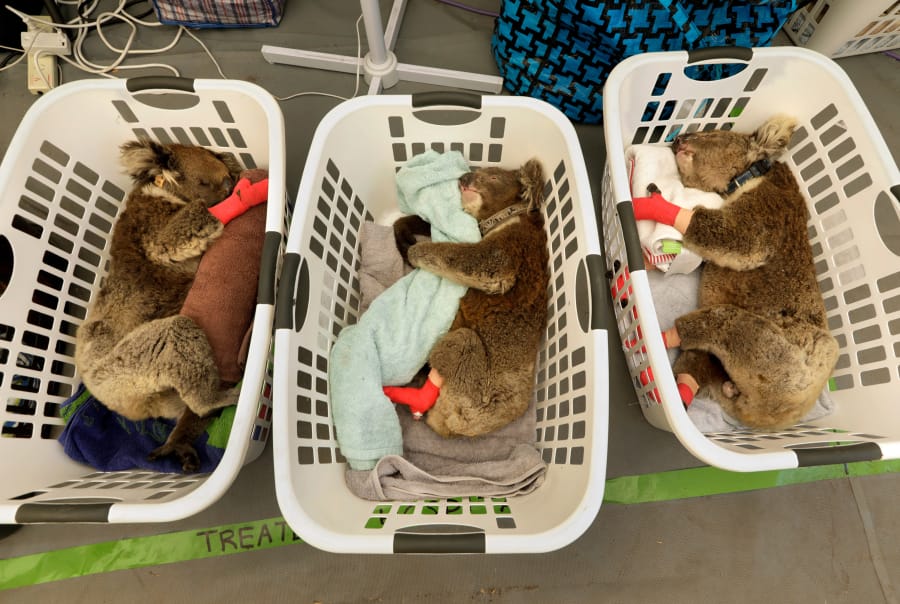KANGAROO ISLAND, Australia — Sam Mitchell balanced himself on a eucalyptus branch 30 feet above the ground as his meaty right fist clutched a koala, which wailed like a pig with breathing problems. The dark gray marsupial batted its 3-inch black claws in the air helplessly, and minutes later Mitchell crawled down. He and the animal were safely on the ground.
Across much of Australia, volunteers and professionals are fighting to contain widespread blazes, with many also taking risks to save wildlife being killed by the millions. Kangaroo Island, a popular tourist destination and wildlife park off Australia’s southeast coast, has been home to some of the worst damage to the nation’s biodiversity. Fires have overrun nearly half of the 1,700-square-mile island, and rescuers including Mitchell have been going tree to tree, trying to save what they can.
“There’s not much that isn’t threatening koalas at the moment,” said Mitchell, who has owned and run the Kangaroo Island Wildlife Park the last seven years.
In terms of human fatalities, Australia’s blazes this year have been less severe than some previous bush fires, with roughly 27 people killed this season compared with 75 during the nation’s 1983 “Ash Wednesday” inferno. But the impact on wildlife this year has been far more devastating.
Scientists estimate that, so far in Australia, fires have killed from hundreds of millions to more than 1 billion native animals. The toll illustrates that, while humans can adapt somewhat to intensifying fires, delicate ecosystems are far more vulnerable.
“Most Australian landscapes are in tune with small-scale summer fires, but not the fires of the proportion and intensity that we are observing now,” said Katja Hogendoorn, a professor at the University of Adelaide’s school of agriculture, food and wine.
“These incomprehensibly large and devastating fires are caused by a combination of lower rainfall and higher temperatures, both consequences of climate change, and here to stay and worsen, unless drastic action is undertaken worldwide,” she added. “As the driest and hottest continent, Australia is at the forefront of this environmental disaster.”
Accurate numbers on animal losses are hard to come by as the disaster continues to unfold, with some fire officials saying blazes will continue to burn into March. But already the damage to natural heritage has become clear. The endangered Kangaroo Island dunnart, a mouselike marsupial, relies on low-lying vegetation for protection from birds. That largely is gone, as is most of the home of the glossy black cockatoo. Much of the landscape is black and smoldering.
On Kangaroo Island, Mitchell’s 50-acre property is surrounded by burn scars but was miraculously untouched by the blazes, and skies that had been choked for days with smoke were clear on Monday. For weeks, the wildlife park has become a refuge for animals rescued by volunteers and passersby.
The carcasses of animals litter the shoulders of the roads that run across the island’s rugged landscape. Most are dead, and others are in such bad shape they uncharacteristically move toward humans, either unable to see or starved and disoriented.
At the park, there’s a pop-up tent where crews tend to medical equipment including IV drip bags, bandages, gauze and saucers filled with iodine. Nearby are laundry baskets where koalas are nestled, their burned paws wrapped and bandaged.
Some are calling the Australia fires an animal apocalypse, a preview of what could happen in California as fires intensify and burn hotter, as they are expected to do under many climate change scenarios.
That prospect concerns many fire ecologists, who long preached that California and other Western states have a long fire history, with flora and fauna adapted to survive — and even thrive after — seasonal fires.
“We have a saying that pyro-diversity begets eco-diversity,” said Dominick DellaSala, chief scientist with the Ashland, Ore.-based Geos Institute, who has studied forest fire ecology extensively in the western U.S.
But the recent super-hot fires in California, and the widespread wildlife deaths in Australia, have some scientists questioning if these unnaturally intense blazes pose a threat to the conventional wisdom, at least in Australia.



